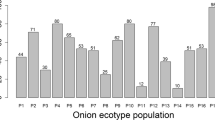Abstract
Wild species are potential sources of genetic diversity for crop improvement. Variation in agronomically important traits has been reported in the wild Cajanus species however, the Australian wild species have not been characterized to date. A subset of four Australian wild Cajanus acutifolius (F.Muell.) Maesen accessions and 57 interspecific hybrids of C. acutifolius, Cajanus lanuginosus (S.T.Reynolds & Pedley) Maesen, Cajanus lanceolatus (W.Fitzg.) Maesen, and two C. cajan genotypes were investigated to assess the phenotypic diversity for 17 qualitative and six quantitative traits. Significant variation in stem thickness, days to 50% flowering (dff) (f.pr < 0.001), and raceme number (f.pr < 0.021) within a group, and plant height, stem thickness, leaf size and dff (f.pr < 0.001) between groups was found. In contrast to earlier reports, some wild C. acutifolius accessions were found to be early (AGG31815WCAJ with 117 days) and medium (AGG316925WCAJ with 140 days) maturating types. Positive correlation of plant height with stem thickness (r = 0.714), and dff (r = 0.780) was observed in late maturing types. Positive correlation of stem thickness with leaf size (r = 0.709), and dff (r = 0.760) were identified in all groups. Even though there was a slight negative correlation of the number of racemes with plant height (r = − 0.126) and stem thickness (r = − 0.190), a considerable positive correlation was observed with secondary (r = 0.536) and tertiary (r = 0.500) branches. The F1s produced with wild Cajanus acutifolius as the female parent were sterile demonstrating the potential for use in hybrid breeding programs.





Similar content being viewed by others
References
Kameswara Rao N, Reddy LJ, Bramel PJ (2003) Potential of wild species for genetic enhancement of some semi-arid food crops. Genet Resour Crop Evol 50:707–721. https://doi.org/10.1023/A:1025055018954
Khoury CK et al (2015) Crop wild relatives of pigeonpea [Cajanus cajan (L.) Millsp.]: distributions, ex situ conservation status, and potential genetic resources for abiotic stress tolerance. Biol Cons 184:259–270. https://doi.org/10.1016/j.biocon.2015.01.032
Kumari DA, Reddy DJ, Sharma HC (2006) Antixenosis mechanism of resistance in pigeonpea to the pod borer, Helicoverpa armigera. J Appl Entomol 130:10–14. https://doi.org/10.1111/j.1439-0418.2005.01024.x
Maesen J (1983) World distribution of pigeopea. ICRISAT Information Bulletin No. 14, pp 1–40
Mallikarjuna N, Saxena KB, Jadav DR (2011) Chapter 2: Cajanus. In: Kole C (ed) Wild crop relatives: genomic and breeding resources: legume crops and forages, vol 2. Springer, Berlin, pp 21–33
Munoz N, Liu A, Kan L, Li MW, Lam HM (2017) Potential uses of wild germplasms of grain legumes for crop improvement. Int J Mol Sci 18:1. https://doi.org/10.3390/ijms18020328
NBPGR, ICRISAT (1993) Descriptors for pigeonpea [Cajanus cajan (L.) Millsp.]. Biodiversity international, Rome, p 31
Nene YL, Hall SD, Sheila VK (1990) The pigeonpea. In: Nene YL, Hall SD, Sheila VK (eds) International crops research institute for the semi-arid tropics. Wallingford, C.A.B. International
Pundir R, Singh R (1986) Inheritance pattern for pod lenghth and ovule number in wide crosses among Cajanus and Atylosia species. Int J Plant Breed 35:649–652. https://doi.org/10.1007/BF00021875
Pundir R, Singh R (1987) Possibility of genetic improvement of pigeonpea [Cajanus cajan (L.) Millsp.] utilizing wild gene sources. Int J Plant Breed 36:33–37. https://doi.org/10.1007/bf00730644
Radford AE, Dickison WC, Massey JR, Bell CR (1976) Phytography—morphological evidence. Vascular plant systematics. Harper & Row, New York
Sameer Kumar CV, Mula MG, Singh IP, Mula RP, Sexena RK, Ganga Rao NVPR, Varshney RK (2014) Pigeonpea perspective in India. Paper presented during the ‘1st Philippine Pigeonpea Congress’, Mariano Marcos State University, Batac, Ilocos Norte, Philippines, 16–18 December 2014
Sameer Kumar CV et al (2016) Pigeonpea—a unique jewel in rainfed cropping systems. Legume Perspect 11:10
Singh M, Gautam NK, Rana MK, Om P, Dutta DM, Bansal KC (2014) Pigeon pea genetic resources and its utilizationin India, current status and future prospects. J Plant Sci Res 1:1–8
Smykal P et al (2015) Legume crops phylogeny and genetic diversity for science and breeding. Crit Rev Plant Sci 34:43–104. https://doi.org/10.1080/07352689.2014.897904
Srikanth S, Saxena R, Rao M, Varshney R, Mallikarjuna N (2015) Development of a new CMS system in pigeonpea utilizing crosses with Cajanus lanceolatus (WV Fitgz) van der Maesen. Int J Plant Breed 204:289–302. https://doi.org/10.1007/s10681-014-1321-z
Sujana G, Sharma H, Manohar Rao D (2012) Pod surface exudates of wild relatives of pigeonpea influence the feeding preference of the pod borer, Helicoverpa armigera. Arthropod Plant Interact 6:231–239. https://doi.org/10.1007/s11829-011-9179-7
Sulusoglu M, Cavusoglu A (2014) In vitro pollen viability and pollen germination in cherry laurel (Prunus laurocerasus L.). Sci World J. https://doi.org/10.1155/2014/657123
Upadhyaya HD, Pundir RPS, Gowda CLL, Reddy KN, Singh S (2005) Geographical patterns of diversity for qualitative and quantitative traits in the pigeonpea germplasm collection. Plant Genet Res 3:331–352. https://doi.org/10.1079/pgr200587
Upadhyaya HD, Reddy K, Gowda C, Singh S (2007) Phenotypic diversity in the pigeonpea (Cajanus cajan) core collection. Int J 54:1167–1184. https://doi.org/10.1007/s10722-006-9008-5
Funding
This study is a part of my Ph.D. in the University of Queensland. This project has no other funding.
Author information
Authors and Affiliations
Corresponding author
Ethics declarations
Conflict of interest
The authors declare that they have no conflict of interest.
Additional information
Publisher's Note
Springer Nature remains neutral with regard to jurisdictional claims in published maps and institutional affiliations.
Rights and permissions
About this article
Cite this article
Vanambathina, P., Rachaputi, R.C.N., Henry, R.J. et al. Phenotypic variation in Australian wild Cajanus and their interspecific hybrids. Genet Resour Crop Evol 66, 1699–1712 (2019). https://doi.org/10.1007/s10722-019-00818-1
Received:
Accepted:
Published:
Issue Date:
DOI: https://doi.org/10.1007/s10722-019-00818-1




